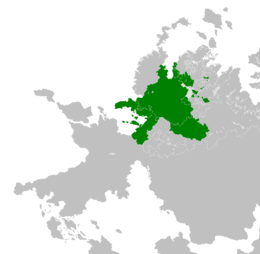First Cuthish Empire
This article is incomplete because it is pending further input from participants, or it is a work-in-progress by one author. Please comment on this article's talk page to share your input, comments and questions. Note: To contribute to this article, you may need to seek help from the author(s) of this page. |
Cuthish Empire | |
|---|---|
| 1444–1797 | |
 The Cuthish Empire at its greatest extent in 1710 | |
| Capital | Kingsham |
| Common languages | Cuthish, Waldish, Widdalian, Hesurian, Pintachee |
| Religion | Semitarism |
| Government | Composite monarchy (1444–1740) Absolute monarchy (1740–1796) Constitutional monarchy (1796–1797) |
| Emperor | |
• 1444–1463 | Godric II |
• 1780–1797 | Edmund IX |
| Legislature | Wittenmoot |
| Historical era | Late Middle Ages Early modern period |
| 11 January 1444 | |
• Cuthish landfall in Alvinia | 1505 |
• Conquest of Valimia | 1507–1528 |
| 1715–1740 | |
| 29 September 1740 | |
| 1775–1778 | |
| 1795–1800 | |
| 6 October 1797 | |
| Currency | Pund |
| Today part of | |
The First Cuthish Empire (Cuthish: First Cuþisc Coaserrice, Hesurian: Erstes Kutisches Reich), officially the Cuthish Empire (Cuthish: Cuþisc Coaserrice, Hesurian: Kutisches Reich) and also known as the Loxstedt-Hoeveden Monarchy, was an imperial power and composite monarchy ruled by the Loxstedt-Hoeveden monarchs of Cuthland and other Berean states from 1444 to 1797. At its height in the 17th century, the Cuthish Empire controlled the majority of the Telmerian Peninsula as well as vast colonial holdings in Alvinia and northern and eastern Pamira, making it the Xth largest empire in history. The First Cuthish Empire was one of the preeminent great powers in Late Medieval and early modern Berea, and led the Age of Discovery along with rival Lavaria.
The Empire was established in the immediate aftermath of the Cuthish conquest of Waldrich, when Godric the Conqueror issued the Proclamation of the Cuthish Empire and declared himself Emperor on 11 January 1444. The conquest had ended a nearly four century long political rivalry between the kingdoms of Cuthland and Waldrich, allowing Cuthland to emerge as the uncontested hegemon in northern Berea. The empire was de facto a composite state with no state institution and held together by the Loxstedt-Hoeveden court. The empire's borders expanded across the Telmerian Peninsula over the next 250 years, and by the mid-17th century extended from the Dentrian Peninsula to western Mascylla and northwestern Dulebia. Cuthland's rise led the Chaghanid Empire to lose exclusive trading rights with many of its Berean economic partners, resulting in the Chaghanids's decline and eventual collapse. The subsequent power vacuum opened the door for Lavish and Cuthish colonization in Pamira, as Cuthish explorers began to establish trade routes with !Japan via the !Northern Passage. Cuthland consequently emerged as the dominant colonial power in northern and eastern Pamira by the late 15th century, establishing colonies across Valimia and !Japan. In 1505, Cuthish explorer Wesley Middelton discovered the Alvinian Archipelago in an attempt to find a western trade route with Pamira, leading to the widespread colonization of Alvinia by the Berean powers. Cuthland was the first Berean nation to establish trade relations with the Indigenous Alvinian peoples, and either influenced or directly controlled most of the continent by the mid-16th century.
The Cuthish Empire entered a long period of decline druing the 18th century. Emperor Edmund VII died without an heir in 1715, resulting in Cuthland's invasion by a coalition between Dulebia, Aldia, and Adwhin in the War of the Cuthish Succession. The war resulted in the First Partition of Cuthland, which ceded many territories in southern and eastern Cuthland and ended imperial hegemony over the Telmerian Peninsula. Consequently, the remaining Cuthish Loxstedt-Hoeveden possessions were formally unified into the Cuthish Empire in 1740. Cuthland was partitioned for a second time in 1778 following the First Cutho-Mascyllary War, leading to an internal economic crisis that weakened the monarchy and resulted in the Cuthish Revolution. After a brief flirtation with constitutional monarchy, republican revolutionaries executed the royal family on 10 September 1797 and abolished the monarchy on 6 October, officially bringing the Empire to an end.


